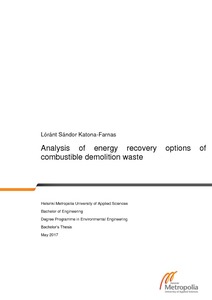Analysis of energy recovery options of combustible demolition waste
Katona Farnas, Lorant (2017)
Katona Farnas, Lorant
Metropolia Ammattikorkeakoulu
2017
All rights reserved
Julkaisun pysyvä osoite on
https://urn.fi/URN:NBN:fi:amk-2017060212040
https://urn.fi/URN:NBN:fi:amk-2017060212040
Tiivistelmä
Construction and Demolition Waste represents approximately one fourth of the total solid waste generated inside the European Union. Its proper management is a key issue due to the EU recycling target, rising raw material prices and landfill space scarcity. The most desirable management options are the re-use, material recycling, energy recovery and eventually landfilling. However, prioritization can be neglected if there are sufficient evidence that originally less desirable options can bring more environmental benefits.
This thesis aimed to analyze different waste management options for the combustible fraction of demolition waste, with emphasize on energy recovery technologies. The chosen technologies were the combustion with energy recovery and gasification. A simplified Life Cycle Analysis has been carried out in order to ease the comparison of these technologies in the case of two buildings situated in the Great Helsinki area, that are going to be demolished. The system boundaries include transportation and the selected thermochemical treatments. Two different scenarios have been built up, one with mainly wood containing demolition waste and the second having as subject mixed demolition waste based on fossil carbon. Three environmental impacts and energy recovery have been included in the analysis. Calculations were based on emission limit values, average energy content of certain materials, and assumptions. Results of the analysis should be treated by keeping in mind the uncertainty about the data quality, the amount of assumptions and the site-specific nature of study.
The results of the analysis show that each technology and the accompanying logistics have their advantages and drawbacks. Plant efficiency plays a dominant role in energy recovery, meanwhile transportation distance has its own important share in environmental burdens. Final decision regarding the most suitable energy recovery technology for demolition waste should be based on factors such as distance between demolition site and waste treatment facilities, composition, quality, level of contamination and energy content of the waste. Further data collection and studies are needed lower the uncertainty of the results and to facilitate the decision making.
This thesis aimed to analyze different waste management options for the combustible fraction of demolition waste, with emphasize on energy recovery technologies. The chosen technologies were the combustion with energy recovery and gasification. A simplified Life Cycle Analysis has been carried out in order to ease the comparison of these technologies in the case of two buildings situated in the Great Helsinki area, that are going to be demolished. The system boundaries include transportation and the selected thermochemical treatments. Two different scenarios have been built up, one with mainly wood containing demolition waste and the second having as subject mixed demolition waste based on fossil carbon. Three environmental impacts and energy recovery have been included in the analysis. Calculations were based on emission limit values, average energy content of certain materials, and assumptions. Results of the analysis should be treated by keeping in mind the uncertainty about the data quality, the amount of assumptions and the site-specific nature of study.
The results of the analysis show that each technology and the accompanying logistics have their advantages and drawbacks. Plant efficiency plays a dominant role in energy recovery, meanwhile transportation distance has its own important share in environmental burdens. Final decision regarding the most suitable energy recovery technology for demolition waste should be based on factors such as distance between demolition site and waste treatment facilities, composition, quality, level of contamination and energy content of the waste. Further data collection and studies are needed lower the uncertainty of the results and to facilitate the decision making.
